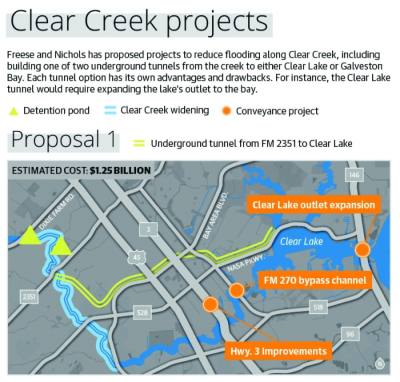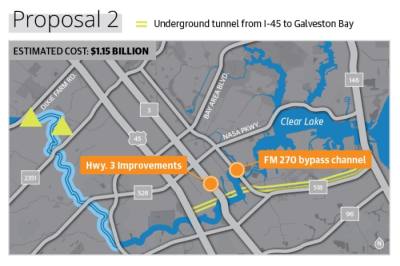Consulting firm Freese and Nichols came up with the proposed projects after a year of research of the Clear Creek and Dickinson Bayou watersheds.
As communities fund local drainage projects and potentially part of the $32 billion coastal barrier in Galveston, local municipalities will have to consider how to afford additional regional flooding fixes.
“We always knew this was going to be a lot of hard work followed by another order of magnitude of harder work,” said Chuck Wolf, an associate with Freese and Nichols. “The funding side of this is a big challenge.”
Proposed projects
On March 31, Freese and Nichols presented regional drainage projects for Clear Creek, which runs through Friendswood and League City. Proposed solutions for the area relate to conveyance, the act of moving water, and detention, the act of holding excess water in place, totaling $275 million.
Adding nearly $900 million to $1 billion to the cost is the proposal to build one of two underground tunnels. One would run from FM 2351 to Clear Lake, and the other would run from I-45 to Galveston Bay.
Over a 50-year period, the conveyance, detention and one of the two tunnel projects would save an estimated 2,298 to 3,109 structures from flooding and prevent $71 million to $95 million in damages, said Brian Gettinger, Freese and Nichols project manager.
Along Dickinson Bayou, the proposed projects are not as costly.
Similar to Clear Creek, Freese and Nichols proposed building detention ponds along Dickinson Bayou, but the biggest component is a 500-foot-wide bypass channel that would divert water from Dickinson Bayou east of I-45 to Dickinson Bay. The estimated cost is $500 million.
Over 50 years, these solutions would save 15,000 structures from flooding and prevent $245 million in damages, Gettinger said.
“A huge number of structures are removed from the flooding risk,” he said.
For both sets of projects, buyouts of properties either prone to flooding or in the way of certain projects, such as the bypass channel, would likely be required, Gettinger said.
For both watersheds, projects cannot worsen flooding downstream. The same parameter exists for the $295 million federal project along the upstream portion of Clear Creek that separates Harris and Brazoria counties, officials said.
Funding questions
Facing over $1.6 billion in potential costs, Freese and Nichols officials and League City leaders, who initiated the study, said they were not surprised by the high price tags.
“When we first started on this project, we actually tried really hard to do this without tunnels in the Clear Creek area,” said Wolf, who noted Clear Creek’s mostly developed land does not allow for inexpensive solutions. “I wasn’t surprised at the cost. That doesn’t mean that I’m not concerned about it.”
League City City Manager John Baumgartner agreed.
“I think we knew the tunnel solution was in the billion-dollar range,” he said. “If we can do something to arrest the potential for flooding in the region, ... hopefully we will see some savings on the insurance side.”
Marika Fuller is a vocal League City resident who has fought for flooding solutions in her subdivision of Bay Ridge. She said the proposed projects have potential, even though the study itself did not contain any surprises for residents who have been advocating for drainage solutions for years.
“Several of these proposals will definitely help everybody,” she said, referencing the many municipalities within the Clear Creek and Dickinson Bayou watersheds.
That said, even with hundreds of millions of projects proposed, some areas cannot be completely alleviated of flood risk, and the area cannot afford the proposed projects to begin with, Fuller said.
“Is the state of Texas going to come up with $1.6 billion for League City, Friendswood, Dickinson? I don’t think so,” she said. “It’s not realistic. It’s wishful thinking.”
Fuller said officials are not thinking big enough; larger projects that affect an even greater region must be considered to truly make a long-term impact taxpayers can afford.
Officials have more faith in the projects’ affordability.
Gettinger said there are several potential funding partners. State offices such as the Texas General Land Office to federal groups such as the Army Corps of Engineers may be willing to help fund projects with a local match, but funding partners come with their own challenges. For instance, state and federal funding partners have their own parameters to ensure projects attain certain cost-benefit ratios, Gettinger said.
Local funding
A local funding option would be to create a Dickinson Bayou flood control district or revive the one that once existed in the Clear Creek watershed.
The Clear Creek Flood Control District, which covered area counties including Harris and Galveston, was created by the Texas Legislature in the mid-1990s to fund regional drainage projects. A vote by residents to grant taxing authority to the district failed in the late ‘90s, so the district was never fully established, and it would take legislative approval to revive it, officials said.
In a similar but unrelated vein, the Gulf Coast Protection District made up of Galveston, Harris and other counties is being considered at the state level to help fund the coastal barrier to protect the Greater Houston area from storm surge flooding, said state Sen. Larry Taylor, R-Friendswood. Meanwhile, the regional projects Freese and Nichols has proposed would alleviate riverine flooding—a separate issue.
House Bill 3029, which would create the Gulf Coast Protection District, has not been finalized, but it is probable the district would need to tax residents at least $0.025 per $100 valuation to afford the maintenance the project would require.
“That’s a very small price to pay for the huge amount of protection we’d be getting,” Taylor said.
Meanwhile, Baumgartner said regional flood control districts could cost as much as $0.25 per $100 valuation, or $600 to $800 annually for the average homeowner.
Fuller said most area taxpayers would not support $1.6 billion worth of projects unless they truly made a massive difference in flooding.
“If there [were] projects that were well thought out and would actually protect the area and increase the value of the area in the long term ... I think most people could accept a tax,” she said. “The controversy about increasing taxes would stump the project immediately. People hate taxes, and I don’t blame them.”
Galveston County Precinct 4 Commissioner Ken Clark, who represents part of League City, said residents will have to decide the importance of flood control.
“People don’t want to flood, and, unfortunately, somebody’s got to pay for these projects,” he said. “Are we really interested in flood control, or are we just giving it lip service?”
Freese and Nichols officials said they have seen cities pull off massive, expensive regional projects before.
“If you have the community support and the political support ... large projects like this can happen,” said Jim Keith, technical lead with Freese and Nichols. “It’s big numbers and big costs, but that doesn’t mean it’s impossible.”
The Freese and Nichols team is going to take feedback it receives about the proposed projects, process it and come back with final recommendations around late May. Those ideas will be pushed out the public, and, ultimately, cities will work to build consensus on what should be done to address flooding, Baumgartner said.
“It’s all for naught if we can’t ... make all our communities more resilient to the flooding,” he said. “I welcome the challenge.”









